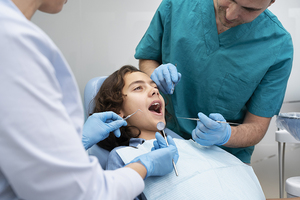ICD-10 and CDT Codes for Two Common Dental Problems
Body
Maintaining good oral hygiene is important to prevent dental problems. Treatment for a dental problem depends on the type and severity of the issue. Dental medical billing and coding can be challenging. Dental practices must be up to date with the codes and payer guidelines to ensure accurate claim submission. This article discusses two common dental problems and their ICD-10 and CDT codes –
Dental Cavity – One of the common dental problems common in children, teenagers and adults, dental cavities causes damage to the hard surface of the teeth and develop into tiny openings or holes. Also called tooth decay or caries, the condition is caused by a combination of several factors like bacteria in the mouth, frequent snacking, sipping sugary drinks and not cleaning teeth. If left untreated, the condition can get larger and affect the deeper layers of the teeth causing severe toothache, infection and tooth loss. Treatment options include fillings (also called restorations), tooth extraction, root canals, crowns and fluoride treatments.
ICD-10 Codes
• K02 Dental caries
• K02.3 Arrested dental caries
• K02.5 Dental caries on pit and fissure surface
• K02.51 Dental caries on pit and fissure surface, limited to enamel
• K02.52 Dental caries on pit and fissure surface, penetrating into dentin
• K02.53 Dental caries on pit and fissure surface, penetrating into pulp
• K02.6 Dental caries on smooth surface
• K02.61 Dental caries on smooth surface, limited to enamel
• K02.62 Dental caries on smooth surface, penetrating into dentin
• K02.63 Dental caries on smooth surface, penetrating into pulp
• K02.7 Dental root caries
• K02.9 Dental caries, unspecified
CDT Codes
• D1206 topical application of fluoride varnish
• D1208 topical application of fluoride – excluding varnish
• D1351 sealant – per tooth
• D1353 sealant repair – per tooth
• D1352 preventive resin restoration in a moderate to high caries risk patient – permanent tooth
• D1354 interim caries arresting medicament application – per tooth
• D1355 caries preventive medicament application – per tooth
Tooth Sensitivity – Also called dentin hypersensitivity, tooth sensitivity occurs due to worn tooth enamel or exposed tooth roots. On the other hand, tooth discomfort is caused by certain other factors, such as a cavity, a cracked or chipped tooth, a worn filling, or gum diseases. The condition refers to pain (sharp, sudden and shooting pain) or discomfort in one or more teeth as a response to certain stimuli, such as hot or cold temperatures. It can affect one tooth, several teeth or all the teeth together and can be a temporary or chronic problem. Treatment will depend on the specific factors causing the sensitivity. If the tooth sensitivity is mild, over-the-counter dental treatments will be suggested. Medical codes for sensitive teeth include –
ICD-10 Codes
• K03.89 Other specified diseases of hard tissues of teeth
• K03.9 Disease of hard tissues of teeth, unspecified
CDT Codes
• D4270-Pedicle soft tissue graft
• D4273 – Autogenous connective tissue graft procedure (including donor and recipient surgical sites) first tooth, implant, or edentulous tooth position in graft
• D4275 Soft tissue allograft
• D4276 Combined connective tissue and double pedicle graft, per tooth
• D4283 Autogenous connective tissue graft procedure (including donor and recipient surgical sites)-each additional contiguous tooth, implant or edentulous tooth position in same graft site
• D4285 Non‐Autogenous connective tissue graft procedure (including recipient surgical site and donor material) – each additional contiguous tooth, implant or edentulous tooth position in same graft site
• D3331 Treatment of root canal obstruction; non-surgical access
• D3346 Retreatment of previous root canal therapy – anterior
• D3347 Retreatment of previous root canal therapy – bicuspid
• D3348 Retreatment of previous root canal therapy – molar
Getting regular dental checkups can prevent or slow oral health issues. For accurate and timely billing and claims submission, dental practices can outsource coding to a reliable dental billing company that provides the services of AAPC-certified coding specialists.







Comments